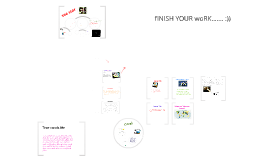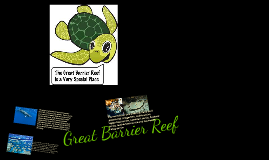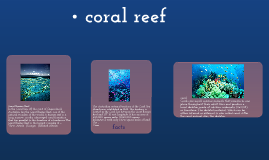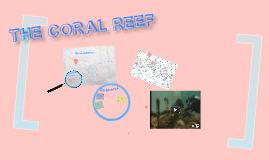coral reef
Transcript: Where our Fishes are located True coral fish are unique, they're located in the Indian oceans with other wild organisms. Their bravery and stipped colors allows them to survive and stay safe! True corals are males and females , although i have a male true coral fish that has coral penis to help them interact with other true coral female fishes. Habitat Coral HeavenFish The majority of the coral’s energy needs are provided by tiny algae , which live inside the coral and produce food using the sun’s energy from carbon dioxide and water. They live together in a symbiotic relationship. This partnership allows corals to live in nutrient-poor environments where sunlight is a plentiful source of energy and the supply of planktonic food is limited. Corals also use their tentacles to capture tiny marine animals called plankton. At night, the corals’ tentacles extend from their bodies and wave in the water, collecting plankton to eat. Starfish move very slowly along the sea floor using hundreds of tiny tube-feet, Member They can Survive off flake food. They also eat live foods like, Brine Shrimp, Black Worms, Mosquito larvae. True Coral Fish maintain water balance. As the ocean starts warm up the fish start to starve to death. Hurricanes, typhoons, El Niño, coral-eating organisms, and diseases are natural disasters coral reefs have been facing every year. It might destroy some coloni coral. However it also helpful to creat new coloni because when the wave broke the coral and move it to other place, the new coral coloni will creat in the new land. The heaven fish is located mostly in South America. This fish goes up to 6" in length and colors varies. There are male and females heavenfish and the fishes breed. (cc) photo by theaucitron on Flickr Starfish do not have true brains. They have a cluster of nerves called ganglia that form a ring in the centre of the starfish. Group Group Member If a starfish loses one arm it will grow again easily. Branching of Coral sea star use suction in the tube feet for movement and feeding. Heaven Fish that are like little tubes with a circle at the end, that help it to walk and climb; if a wave moves the starfish it will hold onto a rock with its tube feet. size:up to 12 inches across when mature. True coral Member Member Coral Imagie TRUE CORAL FISH ! Asexual Reproduction Environmental disturbances may dislodge some polyps or portions of colonies from the parent colony and deposit them on another part of the reef. Sometimes, newly developing coral colonies split and form separate colonies. Star Fish Coral flower True corals life -You can find this fish in the Gulf of mexico and flordia and other places . They are able to find their way through the most intricate passages by swimming on its side or even upside down. Like its relatives they mate for life and therefore they will often be seen in pairs. They are one of a few fish that mate for life[ Heaven Fish Locomotion and Interesting Facts Clo-Star Member Feeding Physical Description when their population grows sea star can consume entire beds of shellfish Member (cc) photo by theaucitron on Flickr Member sea star are not fish as their nickname (star fish) suggest. star fish size depends on the amount of the food they eat not on their age. they belong to a group of animal called echinoderms,wich means (spiny skin) they are related to brittlestars,sea urchins,sea cucumbers, and sand dollars. sea star have 5 arms ,or rays,connected to a small round body.sea stars detect light with 5 purple eyespots at the end of each arm .the bright orange dot in the center of the body is called the madreporite .this organ pumps water into the sea stars body.this pumping action creats suction at the end of 100 tube feet ,located in paired rows on the underside of the arms copy paste branches if you need more.... ENERGY AND MATTER With the exception of eye spots in the tip of each arm there are no specialised sense organs (such as eyes or ears). These eyespots sense light and smell sea star can devour over 50 young clams in a week invertebrates that live on the ocean floor. Member Other echinoderms are the sea cucumbers and the sea urchin. Member sea star breed in the spring ,producting as many as 2,500,000 eggs.females will feel plump and spongy when their arms filled with eggs. Starfish are hard-skinned animals which have spines that help to protect them. Member sea star Member Coral Reproduction Global warming is one of the problem destroy the coral. Global warming make the raise the sea level and also the temperture in the sea. If the frequency of high-temperature episodes increases as mean temperature gradually rises, corals will experience more frequent and widespread disturbances.” More About The Clo-Star The name of this fish came about because it is a mixture of a clownfish and a starfish. The color of a clo-star varies. Like a starfish does, as well as its texture. The way it is viewed it looks like a clown fish the way it is outlined, but the

















